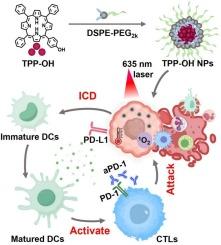Simple porphyrin nanoparticles for combined photo-immunotherapy of colorectal cancer
IF 6
2区 医学
Q2 MATERIALS SCIENCE, BIOMATERIALS
Materials Science & Engineering C-Materials for Biological Applications
Pub Date : 2025-08-18
DOI:10.1016/j.bioadv.2025.214466
引用次数: 0
Abstract
Immune checkpoint inhibitors targeting PD-1 have shown improved survival rates in colorectal cancer patients. Poor clinical response rate due to the low intratumoral infiltration of T lymphocytes limited their further clinical application. Herein, we designed mono-hydroxyphenyl porphyrin (TPP-OH) for synergistic photothermal therapy (PTT)/photodynamic therapy (PDT)-immunotherapy against colorectal cancer. TPP-OH can assemble into stable nanoparticles (TPP-OH NPs) with the help of DSPE-PEG2K. The as-prepared TPP-OH NPs exhibit excellent photothermal and photodynamic performance upon light irradiation. After systemic injection, TPP-OH NPs can locate at tumor site, and produce robust singlet oxygen (1O2) and local hyperthermia, which not only synergistically induces cell death through PDT and PTT effect, but also produces ICD effect to trigger antitumor immune response, thus synergizing with anti-PD-1 to achieve primary tumor control while suppressing metastatic progression. This study provides theoretical guidance for enhancing colorectal cancer treatment through the integration of phototherapy and immunotherapy.

单纯卟啉纳米颗粒用于大肠癌光免疫联合治疗
靶向PD-1的免疫检查点抑制剂已经显示出结直肠癌患者生存率的提高。由于肿瘤内T淋巴细胞浸润率低,临床疗效差,限制了其进一步的临床应用。在此,我们设计了单羟基苯基卟啉(TPP-OH)用于光热治疗(PTT)/光动力治疗(PDT)-免疫治疗大肠癌。在DSPE-PEG2K的帮助下,TPP-OH可以组装成稳定的纳米颗粒(TPP-OH NPs)。制备的TPP-OH NPs在光照射下表现出优异的光热和光动力性能。全身注射后,TPP-OH NPs可定位于肿瘤部位,产生强大的单线态氧(1O2)和局部热疗,不仅通过PDT和PTT效应协同诱导细胞死亡,还可产生ICD效应触发抗肿瘤免疫应答,从而与抗pd -1协同作用,在抑制转移进展的同时实现肿瘤的原发控制。本研究为加强光疗与免疫治疗相结合的结直肠癌治疗提供理论指导。
本文章由计算机程序翻译,如有差异,请以英文原文为准。
求助全文
约1分钟内获得全文
求助全文
来源期刊
CiteScore
17.80
自引率
0.00%
发文量
501
审稿时长
27 days
期刊介绍:
Biomaterials Advances, previously known as Materials Science and Engineering: C-Materials for Biological Applications (P-ISSN: 0928-4931, E-ISSN: 1873-0191). Includes topics at the interface of the biomedical sciences and materials engineering. These topics include:
• Bioinspired and biomimetic materials for medical applications
• Materials of biological origin for medical applications
• Materials for "active" medical applications
• Self-assembling and self-healing materials for medical applications
• "Smart" (i.e., stimulus-response) materials for medical applications
• Ceramic, metallic, polymeric, and composite materials for medical applications
• Materials for in vivo sensing
• Materials for in vivo imaging
• Materials for delivery of pharmacologic agents and vaccines
• Novel approaches for characterizing and modeling materials for medical applications
Manuscripts on biological topics without a materials science component, or manuscripts on materials science without biological applications, will not be considered for publication in Materials Science and Engineering C. New submissions are first assessed for language, scope and originality (plagiarism check) and can be desk rejected before review if they need English language improvements, are out of scope or present excessive duplication with published sources.
Biomaterials Advances sits within Elsevier''s biomaterials science portfolio alongside Biomaterials, Materials Today Bio and Biomaterials and Biosystems. As part of the broader Materials Today family, Biomaterials Advances offers authors rigorous peer review, rapid decisions, and high visibility. We look forward to receiving your submissions!

 求助内容:
求助内容: 应助结果提醒方式:
应助结果提醒方式:


